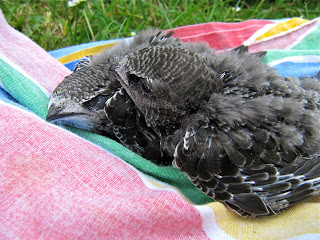Yesterday, I and other members of East Norfolk Ringing Group met with the RSPB voluntary wardens of the Little Tern colony at Caister Beach. The colony, originally located on the shingle at the Great Yarmouth North Denes SSSI/SPA, has a long association with one of the founders of ENRG with Arthur Bowles having been ringing Little Terns there for at least fifteen years.
2010, however, was a desperate year for the terns and all those involved with managing them as the colony deserted the North Denes and failed to settle at alternative locations such as the beach at Winterton which has often had a few pairs attempting to nest there. The reasons for this are still not really known but may be related to a problem with food availability or the long term predation by local kestrels, an issue which has long dogged the Little Terns at Great Yarmouth and one which the RSPB have attempted to resolve through supplementary feeding the kestrel broods.
This year the colony has again moved from the North Denes although a nesting attempt was made there and has fragmented into a number of smaller colonies along the Norfolk and Suffolk coastline ranging from Kessingland to Winterton. The largest of these is the colony on Caister Beach and the RSPB have already done a good job of fencing the colony off, setting up an electrified perimeter and implementing round the clock watches to ward off predators such as foxes, hedgehogs and birds of prey.
Accompanied by the RSPB wardens and volunteers we walked slowly through the colony being constantly mindful of each footstep to avoid the extremely well camouflaged eggs and chicks of the Little Terns as well as Ringed Plover which also nest on the beach. Little Tern chicks are highly mobile from a very young age and many were found hiding away from the nest scrape in clumps of Marram Grass.
Little Tern pullus
Saturday's visit was the first of two with 23 chicks being ringed on the first visit and 9 on the second with 14 retraps. The second visit also saw Arthur locate a Ringed Plover chick which I had the pleasure of ringing.











